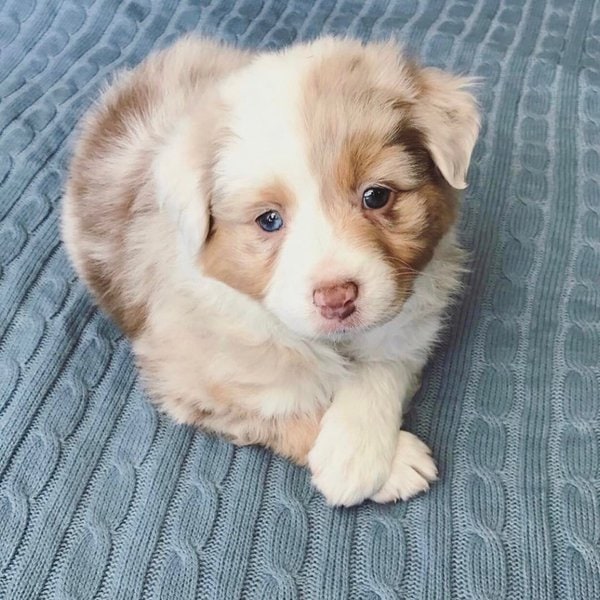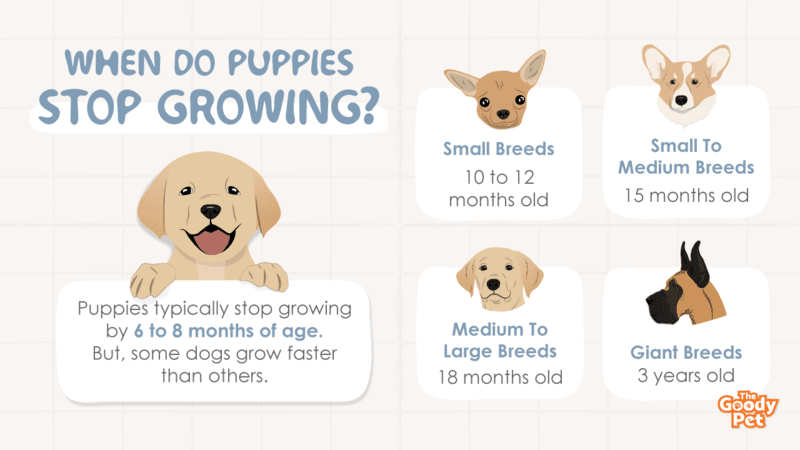As the parent of a growing puppy, you may be wondering just how big they’re going to get.
Puppies typically stop growing by 6 to 8 months of age. Some breeds, however, keep growing until they’re a year old. To determine when your puppy will be done growing, you’ll need to take into account its breed, size, and weight.
If you have a small or medium-sized breed puppy, he’ll probably be finished growing by the time he’s 6 to 8 months old. But if you have a large or giant breed puppy, he may not be done growing until he’s 10 to 12 months old.
And some extra-large breeds don’t reach their full adult size until they’re 18 to 24 months old!
When Do Puppies Stop Growing?
Not all dogs stop growing at the same age. That much depends on the size of the dog. Generally speaking, the bigger the dog, the more time it needs to reach its full size, and vice versa, smaller dogs reach maturity much sooner.
Small Breeds
Chihuahuas are the typical representative of small dog breeds. They need ten to twelve months to reach their full size.
Small To Medium Breeds
Miniature Schnauzers, Beagles, and Toy Poodles fall in the category of small to medium dog breeds. Typically, they are done growing by their 15th month and need two or three additional months to reach their full weight.
Medium To Large Breeds
Typical representatives of this category of dogs are the Boxers, Labrador Retrievers, and the Collies. They need around 18 months to stop growing and an additional six to reach their full weight.
Giant Breeds
The Mastiffs and the Great Danes are typical representatives of this class of dogs. The growing process for them stops when they are three years old. However, they are pretty much grown when they are a year and a half old.
When it comes to giant breeds, it is their paws that reveal whether they are fully grown. When they are just small pups, their paws look more significant than what you’d expect them to, disproportional to their other parts. Once they are fully grown into their paws, they will look like they should, well-proportioned to the rest of their body. That’s how you tell if a big dog has grown to its full size or it got more growth ahead.
Why Do Some Dogs Grow Faster Than Others?

As mentioned earlier, small breed dogs stop growing much sooner than larger breed dogs. For example, when Chihuahua puppies are born, they weigh around 5 ounces. When they reach maturity, they weigh 5 lbs or so. Mathematically speaking, they increased their overall size by a factor of 15.
For comparison, when a Great Dane puppy is born, it weighs around one pound and reaches some 100 lbs and above at maturity. That translates into a factor of a hundred. It only takes much longer to convert food into new tissue. That is why larger breeds need more time to reach maturity as opposed to their smaller counterparts that need much less time.
On average, smaller dogs stop growing when they are six to eight months old, while for larger breeds that period can vary from one year to eighteen months.
Factors That Can Affect Growth Rate
The dog’s breed might be a significant factor that determines a dog’s growth rate, but some additional factors impact it as well. The next two most significant factors are the dog’s genetic code and nutrition.
#1. Genetic Code Differences
Each dog has its particular genetic code that has a significant impact on its growth period. Some genetics are inherited from the parent to the puppy, while others are a consequence of a random variation that happens during a process called DNA recombination.
#2. Nutrition
If a puppy doesn’t get all its proteins and minerals from its food, then the pace of its growth can be strongly affected, along with its overall health. Therefore, it’s important to keep it on a diet that contains at least the necessary minerals and proteins for healthy development. Other than that, the pup may grow at a much slower pace than what is typically expected or in some cases will never get to grow into its normal range.

#3. Neutering Or Spraying
It’s a common misconception that spaying or neutering can affect the pup’s growth. There are those that believe it will alter the growth process to the extent that the pup won’t grow as large as it is supposed to.
Speaking strictly technically, neutering and spaying does trigger a slight and very subtle change in the pup’s growth rate. And yes, there is a specific effect on the adult size of the dog. However, note the terms “slight” and “subtle.” Meaning the chances are so subtle they are virtually unidentifiable.
Dogs altered before their sixteenth week get to grow slightly bigger than those that are not neutered or spayed.
Nevertheless, the point is that hormones are not what primarily drives growth – a dog’s genes and nutrition are. The only way to see the difference between pups that have been neutered or spayed with those that haven’t been being only through tons of data spread in charts and tables featuring hundreds or thousands of cases.
To that end, it is fair to conclude that the decision to neuter or spay your pet will not remarkably affect its growth.
Final Thoughts
The smaller the dog the sooner it will grow mature, and vice versa. There is no way to influence that. Also, there is no way to influence its genetics. That’s given by its parents. The only thing that one can influence, concerning growth rate and how big it will grow is nutrition.
Therefore, feed it properly and love it unconditionally. That’s a proven recipe for growing a pup into an awesome dog.





